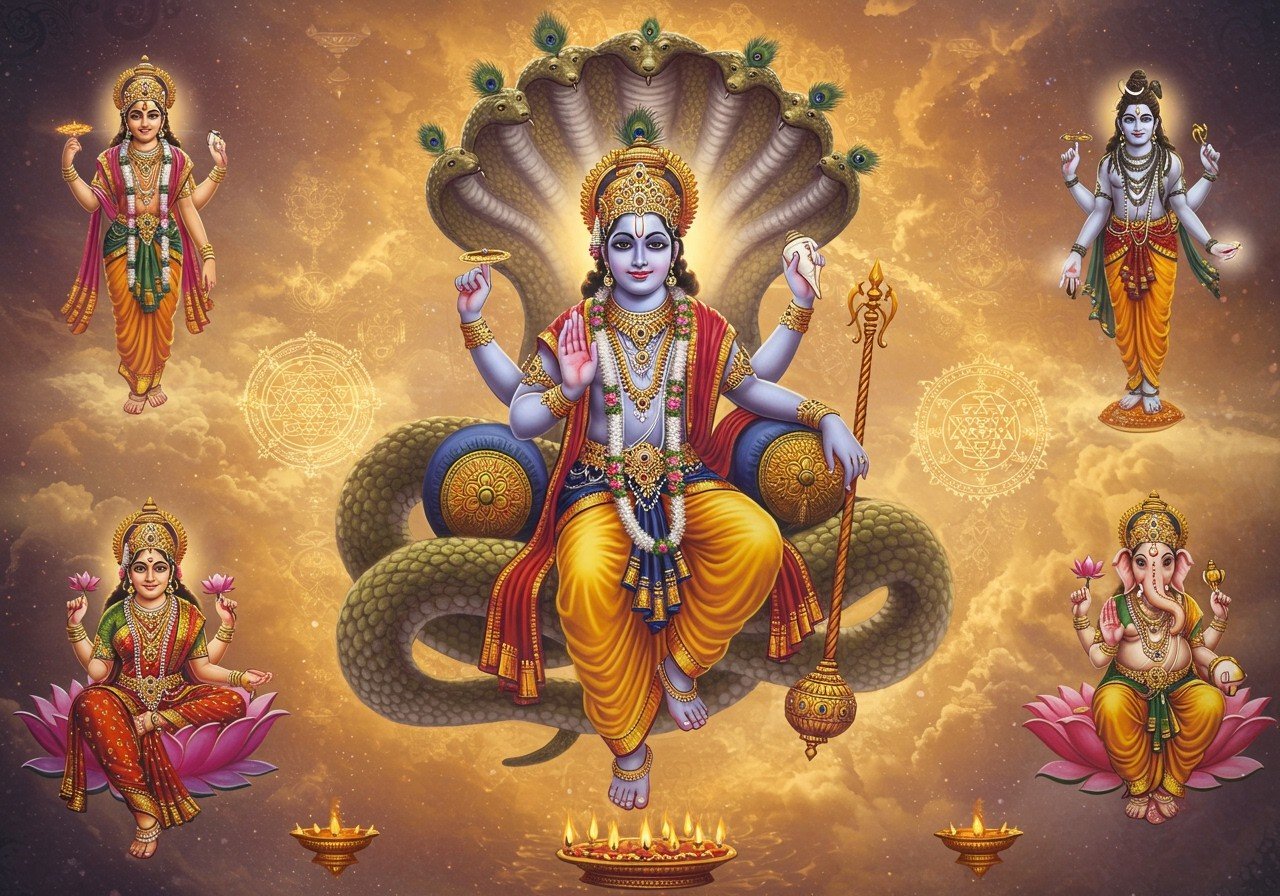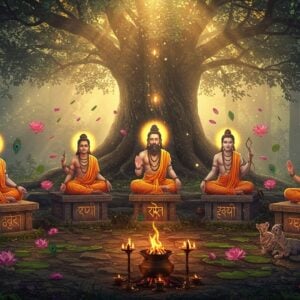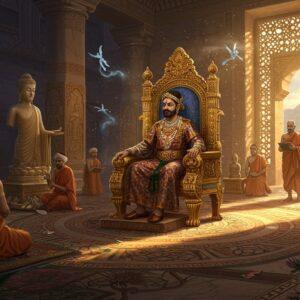
Hinduism beautifully employs symbols, each carrying deep spiritual significance rooted in Hindu philosophies, teachings, and cultural traditions. These symbols often convey the philosophies, teachings, and cultural traditions of Hinduism. They can be broadly categorized into two main types: mudras (hand and body gestures) and murti (icons, drawings, statues). The significance of these symbols may vary depending on the region, period, and tradition.
Popular Hindu Symbols and Their Meanings
Let’s explore some well-known symbols and their meanings:
- Aum/Om: This sacred sound is believed to be the universe’s creation sound. Chanting it brings peace and tranquility. It is considered the most sacred symbol in Hinduism.
- Swastika: In Hinduism, the swastika stands for good fortune and prosperity. Its four arms and dots symbolize Dharma, Artha, Kama, and Moksha—essential elements of life. In Sanskrit, “swastika” means “well-being”.
- Lotus Flower (Padma): The lotus represents purity and spiritual awakening. It teaches us to rise above difficulties and shine brightly, just as the lotus blossoms beautifully from muddy water. It also symbolizes love, divinity, and the potential to rise above challenging circumstances.
- Trishula (Trident): Lord Shiva’s trident symbolizes protection and power. Its three prongs represent desire, action, and wisdom, reminding us to balance these aspects of life. It also represents Shiva’s control of mind, body, and spirit, signifying his power to destroy evil and ignorance.
- Shankha (Conch Shell): Associated with Vishnu, it signifies the sacred Om sound and the victory of good over evil. It is used to call the faithful to prayer and represents the power of divine sound.
- Tilak: This sacred mark, often applied on the forehead at the Ajna Chakra, represents sanctity and respect. The Ajna Chakra, the space between the eyebrows, is considered the seat of wisdom and consciousness.
- Banyan Tree: This tree symbolizes immortality, long life, good health, and the interconnectedness of all life forces. Its vast, spreading branches represent the continuity of life.
- Kalasha: Used in puja rituals, the Kalasha is a pot filled with water, topped with a coconut surrounded by five mango leaves. It represents any God, particularly Lord Ganesha. Breaking a coconut before Ganesha’s shrine symbolizes overcoming the ego.
- Namaste: A common greeting, “Namaste” translates to “I bow to the divine in you.” It acknowledges the divinity within each individual.
How Poojn.in Helps You Connect with Divine Symbolism
Poojn.in offers a wide selection of authentic ritual items that help you honor the deep symbolism of Hindu deities in your worship practices.
For Shiva Worship:
- Shiva Lingams: Pure copper and brass Shiva lingams available in different sizes, representing the formless divine.
- Rudraksha Malas: Sacred rudraksha malas symbolizing Shiva’s tears of compassion.
- Trishul (Trident): Traditional trishul items showcasing Shiva’s three powers: creation, preservation, and destruction.
- Vibhuti (Sacred Ash): Genuine vibhuti representing spiritual purity and the impermanence of the physical world.
- Bilva Leaves: Essential for Shiva puja, these leaves symbolize the three eyes of Lord Shiva.
For General Deity Worship:
- Murtis: High-quality brass and copper murtis of various deities crafted by skilled artisans.
- Puja Thalis: Complete puja thalis with symbolic items like diya (lamp), bell, and incense holder.
- Cotton Wicks: Pure cotton wicks for aarti representing divine light and knowledge.
- Dhoop and Camphor: Natural camphor and traditional dhoop for sacred offerings, purifying the atmosphere.
- Kumkum and Chandan: Authentic kumkum and chandan for tilak application, symbolizing blessings and auspiciousness.
Visit www.poojn.in to explore our full range of authentic puja items that help you maintain proper symbolic representations in your worship practices. We deliver across India with secure packaging to protect sacred items. Our customer service team can guide you in selecting the right items based on specific deity worship requirements. All items on Poojn.in are carefully selected to maintain ritual purity and proper symbolism.
Embracing Symbols in Daily Life
Incorporating these sacred symbols into daily life enriches our spiritual practices and deepens our connection to Hindu traditions. By understanding their meanings, we honor the wisdom passed down through generations. These symbols serve as daily reminders of the values and teachings that guide us, offering peace and inspiration. Whether through prayer, meditation, or simple daily rituals, let these symbols illuminate your path and strengthen your devotion. May they bring harmony and spiritual fulfillment to your life.
FAQs on Hindu Deity Symbolism and Representation
What are the common symbols associated with Hindu deities?
Common symbols include the lotus flower (purity), conch shell (divine sound), discus (cycle of time), trident (power), and mace (strength), each representing different aspects of the deities and their powers.
Why do some Hindu deities have multiple arms and heads?
Multiple arms and heads symbolize the deity’s superhuman abilities, omnipotence, and capacity to perform many actions concurrently. This imagery conveys their vast power and wisdom.
What does the lotus flower symbolize in Hinduism?
The lotus flower, emerging pristine from muddy water, embodies purity, spiritual awakening, and the potential to rise above life’s challenges. It also signifies beauty and enlightenment.
How does the trident represent Lord Shiva?
The trident, or trishul, represents Lord Shiva’s control over the three fundamental aspects of existence: creation, preservation, and destruction. It signifies his power over the physical, mental, and spiritual realms.
What is the significance of the conch shell in Hindu rituals?
The conch shell, or shankha, is blown during rituals to dispel negative energy and invite positive vibrations. It also symbolizes the primordial sound of creation, Om, and is associated with Lord Vishnu.
Why is Lord Ganesha depicted with an elephant head?
Lord Ganesha’s elephant head symbolizes wisdom, understanding, and a discerning intellect. It reminds devotees to think big, overcome obstacles, and use their intelligence wisely.
What do the discus and mace signify in Lord Vishnu’s iconography?
The discus, or chakra, represents the mind, the cycle of time, and dharma. The mace, or gada, symbolizes strength and the power to vanquish evil forces, underscoring Lord Vishnu’s role as the protector.


